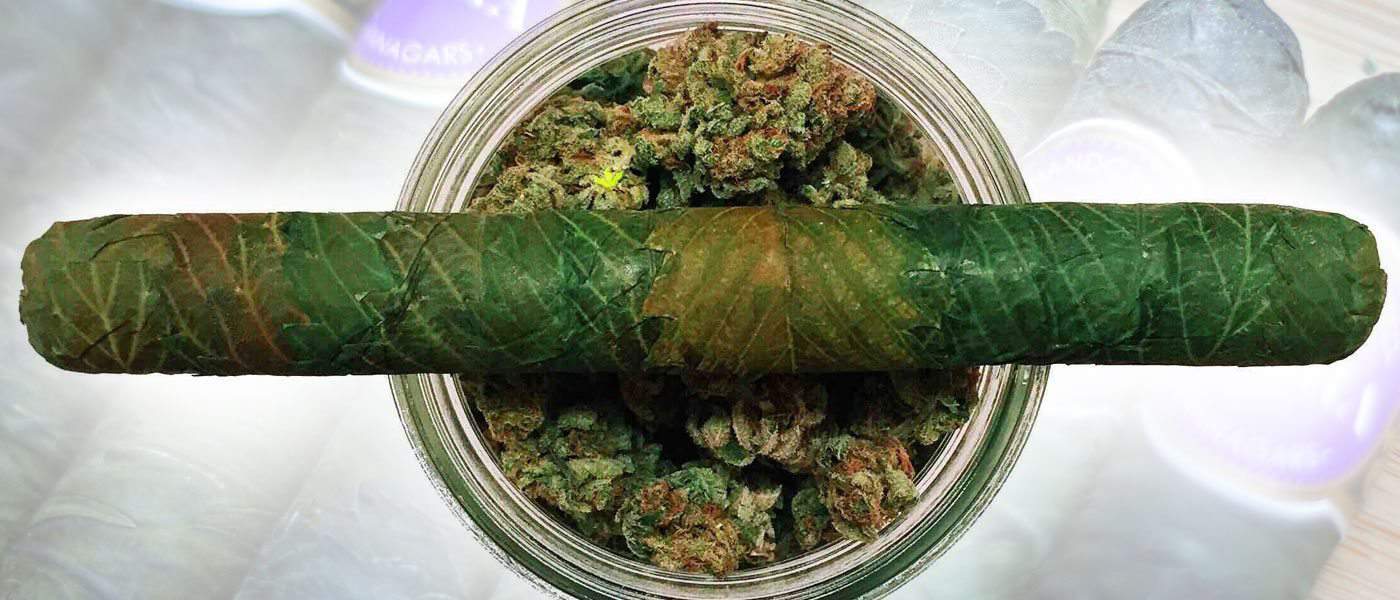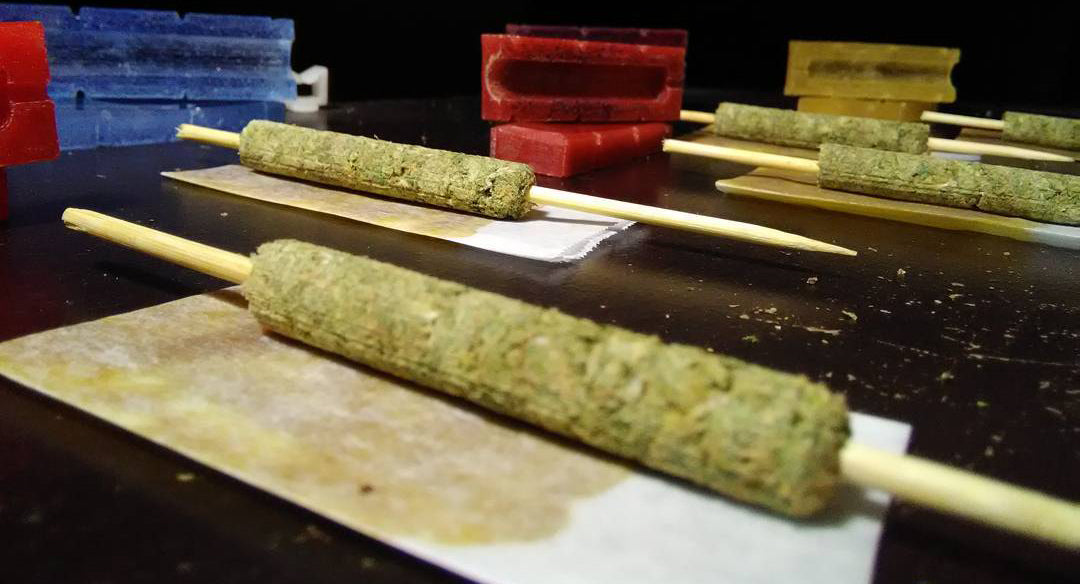Regular tobacco cigars tend to be status symbols for some, props for others (like Groucho Marx), or maybe some form of compensation, but a weed cigar is a whole other smoke! Also known as Thai sticks or cannagars, canna cigars are basically big, fat blunts – potent pot puffers wrapped in cannabis leaves or hemp wraps that use cannabis oil as cigar glue! You can buy cannabis cigars in a few select dispensaries, or you can make your own – which we will get into and which you may want to consider because they are quite expensive at retail; $100 USD is a pretty typical price, with some higher-end pot cigars selling at $420 USD, and there’s even a canna cigar wrapped in a layer of 24-karat, edible gold leaf selling for $10,000 USD! Some larger canna cigars can have up to 12 grams of weed and three grams of cannabis rosin concentrate – so, though pricey stoner smokes, one of these things can be a plump cannabis stick full of potent weed. Do cigars get you high? With as much as they cost and with the amount of marijuana, leaf and concentrate that goes into each pot cigar, they ought to!
About Canna Cigars

Nobody actually enjoys cigars. I am convinced of this. Most people agree with me. Things that are actually enjoyable (and not some bizarre “masculine” ritual) tend to be popular. Cigars are not: more than ninety-five percent of American adults do not smoke cigars, according to the Centers for Disease Control and Prevention. The rest of the population are prime examples of my theory — that clamping an increasingly soggy and noxious smokestack between your teeth for an hour, as your friends and family back away in horror, is not a pleasurable activity — in action.
I live in New York, which is the only place I have ever regularly seen people attempt to conduct life with cigar. Even here, whenever I see a cigar smoker, I see a haunted man. (I am told women smoke cigars but I have only ever seen men do this.) I see someone struggling to endure an ordeal, with clenched jaw and measured breaths, their only solace the knowledge that another noxious burning gasp means their suffering will soon be over.
All this to say that I approached the concept of a cannabis cigar — or a “cannagar,” of course, consistent with the cannabis industry’s inability to come up with a product name that’s not a forced, obvious, and clunky portmanteau — with this context, and thus doubt and dismissal.
“A cannagar is a cigar made of cannabis,” Purple Rose Supply explains. “It’s thicker and longer than a joint and contains five, seven, or upwards of ten grams of cannabis, depending on the size of the mold and how ambitious you are with filling it. It can be wrapped with whatever you like — normal rolling papers, a cigar wrap, or hemp shells available on the internet.”
Why, why would you want to do this when there are so many other effective methods? If an extended smoking session is your goal, why this and why not, say, a low-THC preroll? If you just want an enormous fattie, why this and not a blunt? “What,” I kept asking, like a seeker on top of a mountain without a guru, “What goal does the cannagar accomplish?”
The tobacco cigar, from what I gather, is a (sloppy, overbearing) way to swim in a nicotine bath for an hour or two. That I can appreciate. But last I checked, cannabis doesn’t work that way. It is very easy to get very stoned for a very long time without puffing, puffing, puffing. Why do I need to shove 5 or more grams of flower into a tube? Why do I need to go about life with flower bits stuck in my front teeth? A look or two at the state of cannagar play online only hardened my resolve to keep away. My god, it was garish. Ten grams, plus oil? What is the matter with you all? Too much!
These were the odds the Daly City, California-based Purple Rose Supply G2 cannagar mold ($44; the larger molds that hold up to 10 grams are $49) was up against. That, and some real practical difficulties. With a mold, preparing a cannagar, it turns out, is preposterously easy. It just requires patience. After grinding adequate cannabis, and stuffing it down the mold with a stuffing tool, you’re supposed to let it sit in the mold and cure for a couple of days, or a couple of hours if you can’t wait that long.
I casually mentioned what I was doing to a friend and neighbor who’d just been at a wedding upstate, expecting raised eyebrows and “what the f*ck is that?” Instead, his eyes lit up. “Oh yeah! Those are great,” he said. “We had one at the wedding. Got like fifteen of us totally ripped.” Not only that, he said, he even enjoyed the taste and the experience. It was, he said, fun and good.
Thing is, this good fun also requires an ample amount of weed. This was harder than I imagined. My dispensary-bought supply of top-shelf was running low and the next visit to the West Coast wasn’t for a while.
“Mids,” I said to my delivery guy. (It’s New York.) “I need mids.”
“Mids?” he said, perplexed and disappointed at my disinterest in his menu (it is a very nice menu). “We don’t have mids. Nobody does.”
It took a solid week or two of hectoring and complaining and then a personal visit from his boss — the top guy at this inter-borough delivery outfit — to deliver the goods: rather than a quarter of top-shelf, a big bag of shake and trim and some smalls. (If you want a top-shelf cannagar filled with top-shelf, that’s your business; for my first trip out, I went for economy.)
With the devil’s merry-go-round of alternating swamp-and-oven that is the New York summer finally coming to a close — and with it, the beginning of shorter days hinting of the long slog of an urban winter — an escape down to the Jersey Shore for Labor Day weekend seemed like the proper time to give the cannagar a real go. In this environment, there was a good chance of encountering a cigar smoker. The cannabis version, then, was an appropriate riposte.
I had two for the occasion, both in the hemp shells Purple Rose also sent me (which, at $19 each, seemed wildly expensive and maybe the toughest practical obstacle for regular cannagar smoking. You can also use a Backwoods, as I did for my third cannagar, but those of us eschewing tobacco might be out of luck). The right moment turned out to be an evening barbecue. As we waited for the grillmaster to do his thing, we put a cannagar into the provided wooden tip ($16 for a pack of 10). Even before it was lit and we started to puff, it was already pleasant. So much cannabis roughly ground and put into a tube meant lots of terpenes. After a few dry hits, I felt my receptors primed and ready to go. Once lit — well, it was great! It was smooth and it was pleasant. I tried puffing it a few ways — keeping the smoke in the mouth and top of the throat, like a cigar, and taking more joint-like draws. Neither led to a coughing fit or the need to expel, spitting all over the place, like with a cigar. The one drawback was that 5 grams of cannabis was more than enough for a few people, even with the slow burn. We’d only gotten about halfway through when we decided we’d had our fill and it was time to eat.
The cannagar’s appeal, I think, is for the completist: the cannabis smoker who’s done it all and is looking for something else, something different and maybe a little indulgent for a special occasion, be it a wedding or a party or just the weekend. The partygoer particularly will appreciate how long a few grams last and how many heads they’ll be able to please in an extended session. For my money, I appreciated actually enjoying a long, flavorful, and very present smoke — and can report that, unlike the average cigar user, my experience was neither obtrusive nor absurd.
BACKGROUND:

When it comes to the history of tobacco use, you’re on your own; but when it comes to pot proliferation, we can tell you that cannabis use began centuries ago in Asia, first mentioned in writing by Chinese emperor Shen Nung in 2753 BC (or BCE); it then spread to the Middle East by the 14th century, reached Europe in the 19th century and the United States and the rest of the Americas in the 20th century. And in all of that history, people have come up with numerous ways to smoke or otherwise utilize the benefits of cannabis. Smoking weed has long been the mainstay of marijuana use, long before vaping and dabbing. Pipes and rolled joints are the most basic forms of smoking weed, and cannabis cigars are jumbo joints of a kind.
The original canna cigar was the Thai stick. Thai sticks came to Western cannabis culture in the late 1960s Vietnam era when Americans sent overseas were exposed to the Asian custom of binding cannabis buds to bamboo skewers, dipping them in hash oil or opium, then using fibers from the stalk of the marijuana plant, as well as the leaves, to wrap it all together. It was an intensely potent smoke, and remained popular until the war ended in 1975; though joints, blunts, bongs and vapes have since become the most used marijuana smoking methods, Thai sticks have kind of resurfaced as weed cigars, which are very similar.
(Twined up canna cigars, image from Terp Junkies on Instagram)
HOW TO MAKE A THAI STICK:
If you are wondering exactly how to make a Thai stick, fear not because we have it covered (and you are entirely welcome)!
You will need:
- At least 1/8th ounce of freshly harvested and cured cannabis buds, or flower (for ex Orange Sorbet)
- A wooden skewer made of bamboo or hemp
- Twine or hemp binding cord
- Cannabis oil
- Fresh fan leaves from the cannabis plant of your choice
DIRECTIONS:
- Take 1/8th of your favorite cannabis and smoosh the sticky nugs onto the bamboo stick, then wrap it all up with hemp cord and place into your refrigerator for at least 3 days.
- Following 3 days of curing, unwind the hemp cord or twine from around the weed on a stick.
- Drizzle the weed on a stick with cannabis oil or hash oil to glue on the first layer of pot leaves.
- Begin wrapping the weed on a stick starting closest to the pointy tip end of the skewer, pressing the first leaf toward the center and then wrapping and overlapping the other leaves, covering the cured cannabis all the way to the opposite end.
- Use the hemp rope to rewrap the weed on a stick, securing the first layer of cannabis leaves, and then refrigerate for 24hrs.
- After a day, drizzle cannabis oil or hash oil and spread around the first layer of leaves, then wrap the weed stick in the second layer of cannabis leaves and wrap the hemp cord around it again. Repeat the 24hr curing.